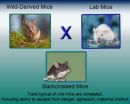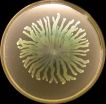(Press-News.org) Washington, D.C.—Astronomers have discovered an extremely cool object that could have a particularly diverse history—although it is now as cool as a planet, it may have spent much of its youth as hot as a star.
The current temperature of the object is 200 to 300 degrees Fahrenheit (100 to 150 degrees Celsius), which is intermediate between that of the Earth and of Venus. However, the object shows evidence of a possible ancient origin, implying that a large change in temperature has taken place. In the past this object would have been as hot as a star for many millions of years.
Called WISE J0304-2705, the object is a member of the recently established "Y dwarf" class—the coolest stellar temperature class yet defined, following the other classes O, B, A, F, G, K, M, L, and T. Although the temperature is similar to that of the planets, the object is dissimilar to the rocky Earth-like planets, and instead is a giant ball of gas like Jupiter.
The international discovery team, led by David Pinfield from the University of Hertfordshire and including Carnegie's Yuri Beletsky, identified the Y dwarf using the WISE observatory—a NASA space telescope that has imaged the entire sky in the mid-infrared. The team also measured the spectrum of light emitted by the Y dwarf, which allowed them to determine its current temperature and better understand its history. Their work is published by Monthly Notices of the Royal Astronomical Society.
Only 20 other Y dwarfs have been discovered to-date, and amongst these WISE J0304-2705 is defined as "peculiar" due to unusual features in its emitted light spectrum.
"Our measurements suggest that this Y dwarf may have a composition and/or age characteristic of one of the Galaxy's older members," Pinfield explained. "This would mean its temperature evolution could have been rather extreme."
The reason that WISE J0304-2705 undergoes such extensive evolutionary cooling is because it is
"sub-stellar," meaning its interior never gets hot enough for hydrogen fusion, the process that has kept our Sun hot for billions of years, and without an energy source maintaining a stable temperature, cooling and fading is inevitable.
If WISE J0304-2705 is an ancient object, then its temperature evolution would have followed through an understood series of stages (as depicted in the illustration): During its first approximately 20 million years it would have a temperature of at least 5,100 degrees Fahrenheit (2800 degrees Celsius), the same as red dwarf stars like Proxima Centauri (the nearest star to the Sun). After 100 million years it would have cooled to about 2,700 degrees Fahrenheit (1,500 degrees Celsius), with silicate clouds condensing out in its atmosphere. At a billion years of age it would have cooled to about 1,800 degrees Fahrenheit (1,000 degrees Celsius), so cool that methane gas and water vapor would dominate its appearance. And since then it would have continued to cool to its current temperature, barely enough to boil water for a cup of tea.
WISE J0304-2705 is as massive as 20-30 Jupiters combined, which is intermediate between the more massive stars and typical planets. But in terms of temperature it may have actually "taken the journey" from star-like to planet-like conditions.
Having identified WISE 0304-2705, Pinfield's team made crucial ground-based observations with some of the world's largest telescopes—the 8-meter Gemini South Telescope, the 6.5-meter Magellan Telescope and the European Southern Observatory's 3.6-meter New Technology Telescope, all located in the Chilean Andes.
Team member Mariusz Gromadzki said: "The ground based measurements were very challenging, even with the largest telescopes. It was exciting when the results showed just how cool this object was, and that it was unusual".
"The discovery of WISE J0304-2705, with its peculiar light spectrum, poses ongoing challenges for the most powerful modern telescopes that are being used for its detailed study" remarked Maria Teresa Ruiz, team member from the Universidad de Chile.
WISE J0304-2705 is located in the Fornax (Furnace) constellation, belying its cool temperature.
There is currently no lower limit for Y dwarf temperatures, and there could be many even cooler and more diverse objects un-detected in the solar neighborhood. WISE went into hibernation in February 2011 after carrying out its main survey mission. However, by popular demand it was revived in December 2013, and is continuing to observe as part of a three-year mission extension.
"WISE gives us wonderful sensitivity to the coolest objects" said Pinfield, "and with three more years of observations we will be able to search the sky for more Y dwarfs, and more diverse Y dwarfs."
INFORMATION:
This publication uses data products from the Wide-field Infrared Survey Explorer, which is a joint project of the University of California Los Angeles and the Jet Propulsion Laboratory/California Institute of Technology, funded by NASA. It also includes data gathered at Las Campanas Observatory; observations made at the La Silla Paranal Observatory; and observations obtained the Gemini Observatory. It made use of the SIMBAD database operated at CDS.
The Gemini Observatory is an international collaboration with two identical 8-meter telescopes. The Frederick C. Gillett Gemini Telescope is located on Mauna Kea, Hawai'i (Gemini North) and the other telescope on Cerro Pachón in central Chile (Gemini South); together the twin telescopes provide full coverage over both hemispheres of the sky. The telescopes incorporate technologies that allow large, relatively thin mirrors, under active control, to collect and focus both visible and infrared radiation from space. The Gemini Observatory provides the astronomical communities in six partner countries with state-of-the-art astronomical facilities that allocate observing time in proportion to each country's contribution. In addition to financial support, each country also contributes significant scientific and technical resources. The national research agencies that form the Gemini partnership include: the U.S. National Science Foundation (NSF); the Canadian National Research Council (NRC); the Brazilian Ministério da Ciência, Tecnologia e Inovação (MCTI); the Australian Research Council (ARC); the Argentinean Ministerio de Ciencia, Tecnología e Innovación Productiva; and the Chilean Comisión Nacional de Investigación Cientifica y Tecnológica (CONICYT). Gemini is managed by the Association of Universities for Research in Astronomy, Inc. (AURA) under a cooperative agreement with the NSF. The NSF also serves as the executive agency for the international partnership.
The research was funded by STFC, RoPACS, a Marie Curie Initial Training Network funded by the European Commissions Seventh Framework Programme, the GEMINI-CONICYT Fund, the Gemini Observatory, a Ramon y Cajal grant, the Spanish ministry of economy and competitiveness, FONDECYT, and CONICYT.
The Carnegie Institution for Science is a private, nonprofit organization headquartered in Washington, D.C., with six research departments throughout the U.S. Since its founding in 1902, the Carnegie Institution has been a pioneering force in basic scientific research. Carnegie scientists are leaders in plant biology, developmental biology, astronomy, materials science, global ecology, and Earth and planetary science.
Planet-like object may have spent its youth as hot as a star
2014-08-05
ELSE PRESS RELEASES FROM THIS DATE:
What drives cybersex addiction among female internet pornography users?
2014-08-05
New Rochelle, NY, August 5, 2014 -- Women who visit Internet pornography sites are at risk of developing cybersex addiction. A comparison of the tendency toward cybersex addiction among heterosexual women who do or do not use Internet pornography and factors predictive of developing cybersex addiction are described in a study published in Cyberpsychology, Behavior, and Social Networking, a peer-reviewed journal from Mary Ann Liebert, Inc., publishers. The article is available free on the Cyberpsychology, Behavior, and Social Networking website.
In "Cybersex Addiction ...
Marital tension between mom and dad can harm each parent's bond with child, study finds
2014-08-05
Children suffer consequences, too, when mom and dad argue or have tension in their relationship, experts warn.
Dads, in particular, let the negative emotions and tension from their marriage spill over and harm the bond they have with their child, says a new study's lead author, psychologist Chrystyna D. Kouros, Southern Methodist University, Dallas.
The findings drive home the conclusion that the quality of a marriage is closely tied to each parent's bond with their child, Kouros said.
The findings are based on data provided by 203 families, where family members completed ...
NASA's Aqua satellite puts two eyes on Hurricane Bertha
2014-08-05
Two instruments or "eyes" from NASA's Aqua satellite were peering at Hurricane Bertha in the North Atlantic Ocean shortly after it became the season's second hurricane. Bertha's hurricane status didn't last long as it weakened to a tropical storm today, August 5.
The Atmospheric Infrared Sounder or AIRS instrument aboard Aqua provides infrared data, while the Moderate Resolution Imaging Spectroradiometer or MODIS instrument provides visible data. Together, these instruments give scientists and forecasters a good look inside and outside of the storm to help determine what's ...
Training schemes help jobless men feel better about themselves
2014-08-05
Do the UK government's welfare-to-work training schemes improve the happiness and well-being of its unemployed citizens? Yes, and especially that of jobless men, says Daniel Sage of the University of Stirling in the UK in an article in Springer's Journal of Happiness Studies. His detailed analysis of data from the UK's Annual Population Survey shows that such active labor market programs that mimic the routines of the workplace work best.
Being unemployed can have a long-term scarring effect on a person's subjective sense of well-being and levels of life worth, happiness, ...
Does your training routine really need to be that complicated?
2014-08-05
This news release is available in French. Ottawa, ON -- A new study just published in the journal Applied Physiology, Nutrition, and Metabolism investigated the value of the Pre-Exhaustion (PreEx) training method and found that that the various arrangements of different exercise protocols is of less relevance than simply performing resistance training exercises with a high intensity of effort within any protocol. As resistance training is becoming a major intervention for health and disease prevention, improved understanding in this area is increasingly important.
PreEx ...
Surprise discovery could see graphene used to improve health
2014-08-05
A chance discovery about the 'wonder material' graphene – already exciting scientists because of its potential uses in electronics, energy storage and energy generation – takes it a step closer to being used in medicine and human health.
Researchers from Monash University have discovered that graphene oxide sheets can change structure to become liquid crystal droplets spontaneously and without any specialist equipment.
With graphene droplets now easy to produce, researchers say this opens up possibilities for its use in drug delivery and disease detection.
The findings, ...
Warning to parents on high acidity drinks
2014-08-05
Dental researchers at the University of Adelaide are warning parents of the dangers of soft drinks, fruit juice, sports drinks and other drinks high in acidity, which form part of a "triple-threat" of permanent damage to young people's teeth.
For the first time, researchers have been able to demonstrate that lifelong damage is caused by acidity to the teeth within the first 30 seconds of acid attack.
The researchers say drinks high in acidity combined with night-time tooth grinding and reflux can cause major, irreversible damage to young people's teeth.
"Dental erosion ...
Pheromones regulate aggression of non-mother female mice toward pups in wild-derived mice
2014-08-05
Laboratory mice are one of the most common animal models used in biological and medical research. Thousands of laboratory mouse strains are produced by artificial selection – the process by which humans breed animals over dozens of generations for particular traits. This has led to the domestication of mice: strengthening specific qualities that make them well-adapted for research under laboratory conditions, such as rapid reproduction, while eliminating characteristics that are not conducive to research, for example, aggression, the desire and ability to escape from danger, ...
Eating more dietary pulses can increase fullness, may help manage weight
2014-08-05
TORONTO, Aug. 5, 2014 – Eating about one serving a day of beans, peas, chickpeas or lentils can increase fullness, which may lead to better weight management and weight loss, a new study has found.
A systematic review and meta-analysis of all available clinical trials found that people felt 31 per cent fuller after eating on average 160 grams of dietary pulses compared with a control diet, according to senior author Dr. John Sievenpiper of St. Michael's Hospital's Clinical Nutrition and Risk Factor Modification Centre.
His group's findings were published in the August ...
Social networking is key to helping bugs spread, study shows
2014-08-05
Fresh discoveries about how bacteria co-operate with each other when causing infection could help scientists identify animal diseases that might transmit to people.
Bugs that can co-operate best with each other are most likely to be able to jump to new species, including humans, a new study shows.
Bacteria interact by releasing molecules to help them adapt to their environment – for example, when killing competing infections in their victim. They co-ordinate these actions by releasing tiny amounts of chemicals as signals.
Bacteria that can co-operate to create an ...





